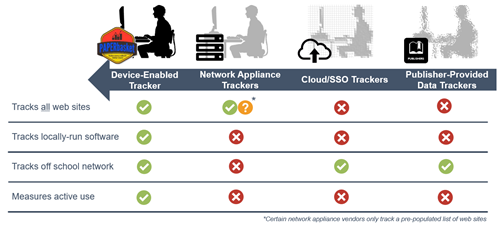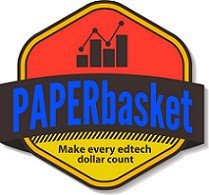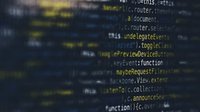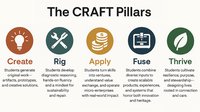FOR IMMEDIATE RELEASE
21 February 2018
A New patent-pending solution collects data at the device level, capable of distinguishing active vs. inactive use
AUSTIN, TEXAS – With K-12 schools now spending in excess of $3B annually on subscriptions for applications, learning platforms and digital content, school district leaders still remain unable to determine if the resources purchased deliver fidelity, or are ever really used at all. Developed by a team of edtech industry veterans, PAPERbasket’s new edtech metering solution offers a brand new patent-pending method of distinguishing active versus inactive use, providing more objective and accurate data than any tool on the market.
“U.S. schools spend over $11B annually in instructional materials, more than 50% reported being in digital formats,” said PAPERbasket President Mark Onderko. “Between content, LMS tools, software and subscription platforms, the typical school system spends $75 to as much as $150 annually per student on dozens to hundreds of subscription-based tools across their district. But how much of that is wasted?” Even beyond dollars, Onderko emphasized that tracking for fidelity and learning outcomes is an even greater challenge for schools, as a recent state study found that 87% of schools did not meet fidelity requirements for their software results in the 2014-15 school year.
Educational organizations suggest as much as 59% of subscriptions are never activated or have zero usage, as per an October 2017 study. That same study found that only 9% of subscriptions met the identified usage goal, using a very small subset of schools and resources.
“Is it because the resources aren’t relevant? Is it because professional development and change management has been lacking? Without accurate usage data, schools will never know,” Onderko added. “Not only will PAPERbasket help ensure schools adopt digital learning more effectively, but by simply identifying the bottom 10-25% of resources being underused by students, that equates to real savings where the district can take immediate action.”
PAPERbasket differs greatly from other accountability tools that have been introduced in recent years. Unique to PAPERbasket is its method of distinguishing "active versus inactive use". While some other companies may measure hits or cumulative time logged into a system, neither of those models tell the full story. If a student logs into a system, only to minimize the screen and watch videos for the next hour, the current products in market have no means of identifying that behavior. PAPERbasket TRACK’s patent-pending technology distinguishes active versus inactive time, so school district leadership knows the difference when a student is actually using a resource, or it’s simply running idle in the background.
“Even the most effective learning resource is useless if students aren’t actually using it,” says Kathy Hurley, former SVP of Pearson Education and currently CEO of Girls Going Global and a Board of Advisor to PAPERbasket. “PAPERbasket solves the missing link to give real, accurate data to know when and if resources are being used.”
PAPERbasket REPORT also offers a wealth of analysis that sets it apart from existing companies. With it, schools can compare use across different digital resources, operating systems and schools. Officials can also run a unique “Return on Education” report, measuring the adoption rate of a particular application and seeing a projected dollar value for the actual payback of active usage. Additionally, PAPERbasket CONNECT allows the data to integrate with existing data-driven platforms, giving you access to new sources of data, through open API standards.
Differentiation
While a few companies have emerged in the user analytics space, their approach to data collection varies greatly. “That differentiation can make a meaningful difference in the data and ultimately in the reports generated,” Onderko added. In the past school year, companies have introduced methods to collect data by compiling claimed use direct from specific publishers, by accessing click-throughs from single sign-on tools or by installing passive DNS appliances on their school networks. In every one of those models, collection methods are unable to collect a true comprehensive picture of edtech usage across the institution, as reflected on the diagram below.

Only PAPERbasket is able to collect data directly from the device, across multiple operating systems, tracking active use of software and web content whether at school, at home, or anywhere in between.
Results So Far
In just the first few months of working with school systems, the team at PAPERbasket was surprised to see what the data was sharing. For example:
- In some school systems, student devices were being used more after dinner (between 6-7pm) than at any time during the school day, suggesting that technology was not evident in many classrooms
- In some school systems, net adoption rates of their most highly productive resources turned out to be lower than the staff anticipated. On average, between 0-15% of students were on track to meet annual usage goals of their most important resources based on the first few months of the school year.
- Many school district CIOs/CTOs get requests almost daily from staff wanting to get pilot subscriptions to new resources. But to afford another new tool, they couldn’t cancel any existing resources, for fear staff will contend it was essential for their students. Now, those same leaders report they can show real data usage, including hours actually used, to justify reducing or eliminating certain resources and subscriptions.
- Schools vary how they would categorize digital resources in terms of academic productivity greatly. For example, some districts classified resources like YouTube and Skype as highly productive while others classified them as “non-productive.” It may suggest differing approaches to digital resources may vary based on the background and experience of those staff making the determinations.
As PAPERbasket continues to grow, there’s many more questions to ask, and ways in which the team hopes PAPERbasket can help make a difference academically. A few that scratch the surface:
- Can we spot digital behaviors that suggest positive and potentially negative learning outcomes, creating an early warning detection system for school officials?
- How do we ensure resources are appropriately adopted before we attempt to measure their impact?
- Which operating systems used in schools deliver the most meaningful usage data, and which are being used more as a distracting than a tool?
- Can we map usage data to student performance to finally answer the question, “Is edtech delivering meaningful student outcomes in ways we can measure?”
In the coming academic year, PAPERbasket plans to help schools answer these and many more questions, as we work together to bring accountability to edtech. “Some schools and some software/content publishers may feel threatened by the questions this sort of data may pose and what it may mean to their business model or local budgets, but in the end, students will benefit from resources they want to use with the most meaningful results,” Onderko added.
About PAPERbasket
PAPERbasket’s mission is simple. We help educators maximize the return on their edtech spend with the first EdTech Adoption Metering Solution. PAPERbasket’s patent-pending solution measures exactly how much active and inactive time students and teachers are using software and digital resources at school, at home, or anywhere in between. Schools can measure adoption rate from any subscription, including an ROI calculator. Founded and led by industry veterans with a cumulative history of over 250 years in edtech alone, the company’s privacy policies were reviewed and approved by the www.studentprivacypledge.org. To learn more about PAPERbasket, watch our 60-second video at www.paperbasket.com and follow us on Twitter @PAPERbasketEDU.
# # #
Contact: Mark Onderko
Telephone: 516-360-3500 ext 804
Cell: 512-484-0323
Email: mark@paperbasket.com
Website: WWW.paperbasket.com
Social Media Posts
Announcing new #edtech analytics solution from @PAPERbasketedu for usage of your digital learning resources www.paperbasket.com
Do you know if your digital learning resources are being used effectively? Get in the know with @PAPERbasketedu solution. #edtech
New: Track #edtech usage of digital learning resources with @PAPERbasketedu analytics software for schools www.paperbasket.com
There’s several ways #edtech companies may collect user analytics but only @PAPERbasketedu can collect a complete picture vs. network appliances and other cloud solutions (https://pbs.twimg.com/media/DWkscFEVMAAKZmI.jpg)











